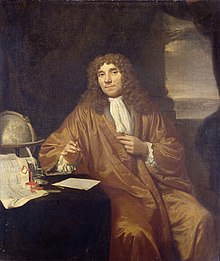Leeuwenhoek-Medaille (Royal Society)

Die Leeuwenhoek-Medaille und Vorlesung (englisch Leeuwenhoek Medal and Lecture) ist eine Auszeichnung der Royal Society, die auf den Gebieten Mikrobiologie, Bakteriologie, Virologie, Mykologie, Parasitologie und Mikroskopie vergeben wird. Sie wird seit 1950 zunächst jährlich, seit 2022 im zweijährigen Abstand vergeben.
Die Preisträger sollen in einem Land des Commonwealth of Nations oder in der Republik Irland ihre Staatsbürgerschaft haben oder seit mindestens drei Jahren dort ihre Wirkungsstätte haben. Bevorzugt werden Wissenschaftler am Anfang oder in der Mitte ihrer Karriere. Trotzdem finden sich (Stand Anfang 2015) unter den 60 Preisträgern sechs spätere Nobelpreisträger (André Lwoff, Jacques Monod, Aaron Klug, Renato Dulbecco, François Jacob und Peter Doherty).
Die Auszeichnung ist nach Antonie van Leeuwenhoek benannt und mit 2000 Pfund Sterling dotiert. Die Preisträger halten eine Vorlesung und erhalten eine Medaille.
Preisträger
Angegeben ist der Titel der Vorlesung oder die Laudatio.
- 1950: Paul Gordon Fildes, The development of microbiology.
- 1951: Christopher Howard Andrewes, The place of viruses in nature.
- 1952: Albert Jan Kluyver, The changing appraisal of the microbe.
- 1953: Kenneth Manley Smith, Some aspects of the behaviour of certain viruses in their hosts and of their development in the cell.
- 1954: Juda Hirsch Quastel, Soil metabolism.
- 1955: Henry Gerard Thornton, The ecology of micro-organisms in soil.
- 1956: Ernest Frederick Gale, The biochemical organization of the bacterial cell.
- 1957: Wilson Smith, Virus-host cell interactions.
- 1958: David Keilin, The problem of anabiosis or latent life: history and current concepts.
- 1959: Frederick Charles Bawden, Viruses: retrospect and prospect.
- 1960: Andre Michel Lwoff, Viral functions.
- 1961: Frank John Fenner, Interactions between poxviruses.
- 1962: Guido Pontecorvo, Microbial genetics: achievements and prospects.
- 1963: Norman Wingate Pirie, The size of small organisms.
- 1964: Donald Devereux Woods, A pattern of research with two bacterial growth factors.
- 1965: William Hayes, Some controversial aspects of bacterial sexuality.
- 1966: Percy Wragg Brian, Obligate parasitism in fungi.
- 1967: James Baddiley, Teichoic acids and the molecular structure of bacterial walls.
- 1968: Gordon Elliott Fogg, The physiology of an algal nuisance.
- 1969: Jacques Lucien Monod, Cellular and molecular cybernetics.
- 1970: Philip Herries Gregory, Airborne microbes: their significance and distribution.
- 1971: Michael George Parke Stoker, Tumour viruses and the sociology of fibroblasts.
- 1972: Hans Leo Kornberg, Carbohydrate transport by micro-organisms.
- 1973: Aaron Klug, The structure and assembly of regular viruses.
- 1974: Renato Dulbecco, The control of cell growth regulation by tumour-inducing viruses: a challenging problem.
- 1975: Joel Mandelstam, Bacterial sporulation: a problem in the biochemistry and genetics of a primitive development system.
- 1976: Geoffrey Herbert Beale, The varied contributions of protozoa to genetical knowledge.
- 1977: Francois Jacob, Mouse teratocarcinoma and mouse embryo.
- 1978: Hugh John Forster Cairns, Bacteria as proper subjects for cancer research.
- 1979: Patricia Hannah Clarke, Experiments in microbial evolution: new enzymes, new metabolic activities.
- 1980: David Arthur John Tyrrell, Is it a virus?
- 1981: Frank William Ernest Gibson, The biochemical and genetic approach to the study of bioenergetics with the use of Escherichia coli: progress and prospects.
- 1982: Hamao Umezawa, Studies of microbial products in rising to the challenge of curing cancer.
- 1983: Michael Anthony Epstein, A prototype vaccine to prevent Epstein-Barr (E.B.) virus-associated tumours.
- 1984: William Duncan Paterson Stewart, The functional organisation of nitrogen-fixing cyanobacteria.
- 1985: Kenneth Murray, A molecular biologist's view of viral hepatitis.
- 1986: William Fleming Hoggan Jarrett, Environmental carcinogens and paillomaviruses in the pathogenesis of cancer.
- 1987: David Alan Hopwood, Towards an understanding of gene switching in streptomyces, the basis of sporulation and antibiotic production.
- 1988: Alfred Rupert Hall, Antoni van Leeuwenhoek (1632–1723) and Anglo-Dutch collaboration.
- 1989: Piet Borst, Antigenic variation in African trypanosomes.
- 1990: John Skehel, How enveloped viruses enter cells.
- 1991: Harry Smith, The influence of the host on microbes that cause disease.
- 1992: John Postgate, Bacterial evolution and the nitrogen-fixing plant.
- 1993: Fred Brown, Peptide vaccines, dream or reality.
- 1994: Keith Vickerman, The opportunistic parasite.
- 1995: John Rodney Guest, Adaptation to life without oxygen.
- 1996: Julian Davies, Microbial molecular diversity - function, evolution and applications.
- 1997: Peter Biggs, Mareks disease, tumours and prevention.
- 1998: George A. M. Cross, The genetics and cell biology of antigenic variation in trypanosomes.
- 1999: Peter Doherty, Killer T cells and virus infections.
- 2000: Howard Dalton, The natural and unnatural history of methane-oxidising bacteria.
- 2001: Robin Weiss, From Pan to pandemic: animal to human infections.
- 2002: Stephen West, DNA repair from microbes to man.
- 2003: Brian Spratt, Bacterial populations and bacterial disease.
- 2004: David Sherratt, A bugs life.
- 2005: Keith Chater, Streptomyces inside out: a new perspective on the bacteria that provide us with antibiotics.
- 2006: Tony Crowther, Microscopy goes cold: frozen viruses reveal their structural secrets.
- 2010: Robert Webster, Pandemic Influenza: one flu over the cuckoo's nest.
- 2012: Brad Amos, How new science is transforming the optical microscope.
- 2015: Jeffrey Errington, Bacterial cell walls, antibiotics and origins of life.
- 2017: Sarah Cleaveland, Can we make rabies history? Realising the value of research for the global elimination of rabies.
- 2019: Geoffrey Smith, Poxvirus research after smallpox eradication: new findings with an old vaccine.
- 2022: Sjors Scheres, for ground-breaking contributions and innovations in image analysis and reconstruction methods in electron cryo-microscopy, enabling the structure determination of complex macromolecules of fundamental biological and medical importance to atomic resolution.
- 2024: Joanne P. Webster for her achievements in advancing control of disease in humans and animals caused by parasites in Asia and Africa.
Weblinks
- Leeuwenhoek Medal and Lecture bei der Royal Society (royalsociety.org)